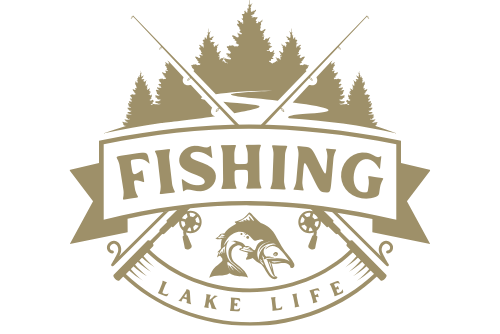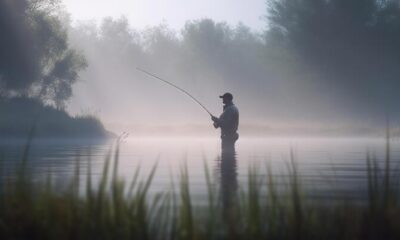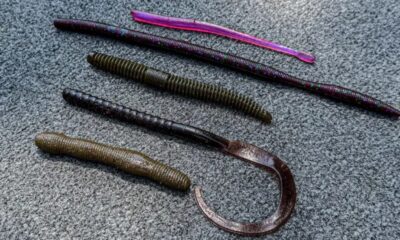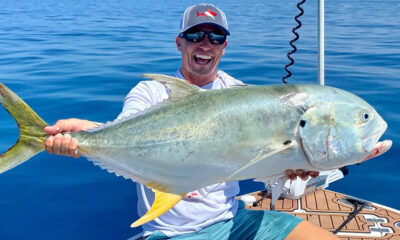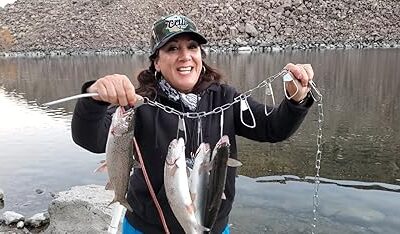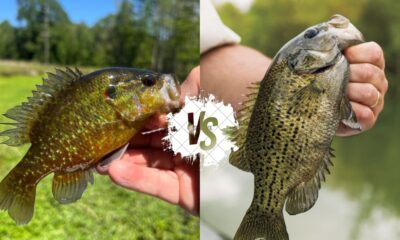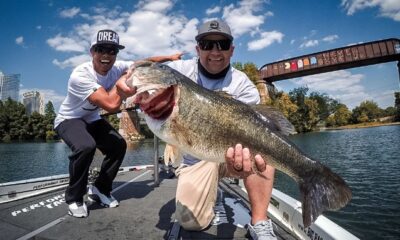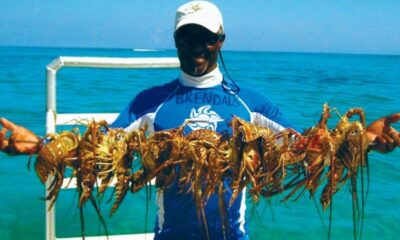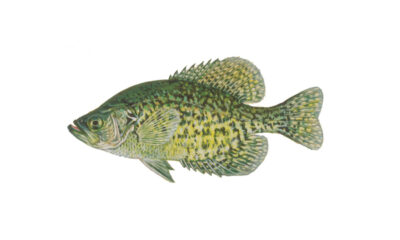Fishing Guides
Finding the Perfect Barometric Pressure for Your Next Fishing Trip
As any seasoned angler knows, the key to a successful fishing trip lies in understanding and anticipating the various environmental factors that influence fish behavior. Among these factors, barometric pressure plays a crucial role in determining when and where fish are most likely to bite. In this comprehensive guide, we’ll explore the intricacies of barometric pressure, its impact on fish activity, and how to leverage this knowledge to maximize your chances of landing that prized catch.
You may also like to read “ Master the Double Jig Rig” article.
Understanding Barometric Pressure
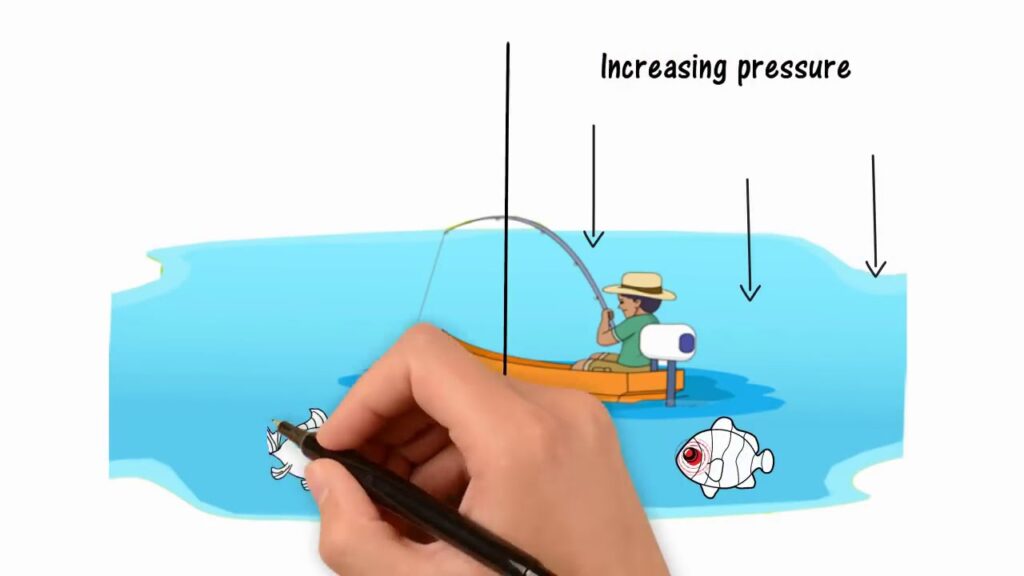
Barometric Pressure
Before we dive into the specifics of how barometric pressure affects fishing, it’s essential to understand what it is and how it’s measured.
Definition and Measurement
Barometric pressure, also known as atmospheric pressure, refers to the weight of the air molecules pressing down on the Earth’s surface. This pressure is measured using a barometer, which can be an aneroid (mechanical) or a digital device.
Barometric pressure is typically expressed in various units, including:
- Millibars (mb)
- Hectopascals (hPa)
- Inches of mercury (inHg)
- Millimeters of mercury (mmHg)
In most weather reports and fishing forecasts, barometric pressure is commonly reported in millibars or hectopascals.
Normal Barometric Pressure Range
The normal range for barometric pressure at sea level is typically between 950 mb (28.05 inHg) and 1050 mb (31.01 inHg). However, this range can vary depending on factors such as altitude, weather patterns, and geographic location.
It’s important to note that barometric pressure is not a static value but rather fluctuates constantly due to changes in weather conditions, such as the formation of high- or low-pressure systems.
The Impact of Barometric Pressure on Fish Behavior
While the reasons behind the relationship between barometric pressure and fish behavior are not fully understood, numerous studies and anecdotal evidence from experienced anglers have shed light on this fascinating phenomenon.
How Barometric Pressure Affects Fish
Fish are incredibly sensitive to changes in barometric pressure, as these variations can impact their physiology and behavior in several ways:
- Buoyancy Control: Fish use their swim bladders to maintain neutral buoyancy and control their depth in the water column. Changes in barometric pressure can affect the volume of gas in their swim bladders, causing them to adjust their depth or position in the water.
- Feeding Habits: Fluctuations in barometric pressure can trigger feeding frenzies or periods of inactivity in fish. Generally, stable or gradually rising pressure is associated with increased feeding activity, while rapidly dropping pressure can cause fish to become lethargic and less willing to feed.
- Spawning Behavior: For some species, barometric pressure changes can influence spawning patterns and migratory behaviors related to spawning.
- Metabolism and Activity Levels: Changes in barometric pressure can affect fish metabolism, impacting their overall activity levels and, consequently, their feeding habits.
Ideal Barometric Pressure for Fishing
While there is no universally accepted “perfect” barometric pressure for fishing, anglers have observed certain patterns and preferences based on their experiences:
- Stable or Gradually Rising Pressure: This condition is often associated with increased fish activity and feeding, making it an ideal time to target various species. A stable or slightly rising barometric pressure typically signals fair weather conditions, which can put fish in a more active and aggressive feeding mode.
- Moderate to High Pressure Ranges: Many anglers report successful fishing outings when the barometric pressure falls within the moderate to high range, typically between 1020 mb (30.12 inHg) and 1040 mb (30.70 inHg). This range is often associated with stable weather conditions and consistent fish behavior.
- Rapidly Falling Pressure: When barometric pressure drops rapidly, fish may become less active and less inclined to feed. However, some species, such as trout and bass, can become more aggressive feeders just before a significant drop in pressure, as they sense an approaching storm or weather system.
It’s important to note that these observations are general guidelines, and fish behavior can vary depending on the species, water conditions, and other environmental factors.
Incorporating Barometric Pressure into Your Fishing Strategy
Now that you understand the significance of barometric pressure in fishing, it’s time to learn how to incorporate this knowledge into your fishing strategy for improved success on the water.
Monitoring Barometric Pressure
The first step in leveraging barometric pressure for your fishing trips is to monitor and track the pressure changes in your local area. There are various ways to access barometric pressure readings:
- Weather Apps and Websites: Many weather apps and websites, such as Weather.com and AccuWeather, provide real-time barometric pressure readings and forecasts for specific locations.
- Handheld Barometers: For anglers who prefer a dedicated device, handheld barometers are available in both analog and digital formats, offering accurate and portable pressure readings.
- Fishing Apps and Websites: Some fishing-specific apps and websites, like FishBrain, incorporate barometric pressure data into their forecasts and predictions.
By regularly monitoring barometric pressure trends, you can plan your fishing trips accordingly and adjust your tactics based on the expected conditions.
Adjusting Your Fishing Tactics
Once you have a solid understanding of the barometric pressure patterns in your fishing area, you can adjust your tactics to increase your chances of success:
- Target Species: Different fish species may respond differently to barometric pressure changes. Research the preferred pressure ranges for the species you’re targeting and adjust your tactics accordingly.
- Lure Selection: Certain lures and presentations may be more effective under specific barometric pressure conditions. For instance, during stable or rising pressure, fish may be more willing to chase and strike topwater lures or fast-moving baits, while during falling pressure, slower presentations with live or natural baits may be more productive.
- Fishing Locations: Fish may change their positioning and depth preferences based on barometric pressure fluctuations. During high or rising pressure, focus on shallow or mid-depth areas, while during low or rapidly falling pressure, try targeting deeper waters or structure where fish may seek refuge.
- Time of Day: Some anglers have observed that fish may feed more actively during certain times of the day based on barometric pressure changes. For example, during stable or rising pressure, early morning and late afternoon/evening hours can be prime feeding times.
- Water Conditions: Barometric pressure can also influence water conditions, such as clarity and oxygen levels, which can impact fish behavior. Adjust your tactics accordingly based on the observed water conditions.
Remember, barometric pressure is just one factor influencing fish behavior, and successful fishing often requires considering various environmental conditions and adapting your strategies accordingly.
Case Studies and Real-Life Examples
To further illustrate the significance of barometric pressure in fishing, let’s explore some real-life examples and case studies from experienced anglers:
Largemouth Bass Fishing During a Stable High-Pressure System
“Last summer, we had a prolonged period of stable, high barometric pressure around 1030 mb (30.41 inHg). During this time, I noticed that the largemouth bass in my local reservoir were incredibly active and aggressive. I had some of my best days fishing shallow flats and points, throwing topwater lures like buzzbaits and hollow-body frogs. The bass were literally exploding on the surface to strike my baits, making for some heart-pounding action.” – Mark, avid bass angler from Texas
Trout Fishing During a Rapidly Falling Pressure System
“One of my most memorable trout fishing experiences was during a rapidly falling barometric pressure system. As the pressure dropped from around 1020 mb (30.12 inHg) to below 990 mb (29.23 inHg), the trout in the river seemed to go into a feeding frenzy. I had success using small nymphs and streamers, targeting deeper pools and undercut banks where the trout were seeking refuge from the approaching storm. It was an incredible day of non-stop action.” – Sarah, fly fishing enthusiast from Colorado
Saltwater Fishing and Barometric Pressure Shifts
“As a saltwater angler, I’ve learned to pay close attention to barometric pressure shifts, especially when targeting species like redfish and snook. During periods of stable or gradually rising pressure, I’ve found that these fish are more willing to feed aggressively on topwater lures and fast-moving baits in shallow flats and mangrove areas. However, when the pressure starts to drop rapidly, I’ll switch to slower presentations with live or cut baits and focus on deeper channels and structure.” – Jason, inshore fishing guide from Florida
These real-life examples illustrate how understanding and adapting to barometric pressure changes can significantly impact an angler’s success on the water. By closely monitoring barometric pressure trends and adjusting tactics accordingly, experienced anglers can capitalize on prime feeding windows and increase their chances of landing that prized catch.
Comparing Barometric Pressure to Other Fishing Factors
While barometric pressure is undoubtedly an essential factor in fishing success, it’s crucial to consider it in conjunction with other environmental and seasonal conditions. Here’s a comparison of barometric pressure with some other key factors that anglers should consider:
| Factor | Importance | Relationship with Barometric Pressure |
|---|---|---|
| Water Temperature | Water temperature plays a significant role in fish metabolism, activity levels, and spawning behavior. | Changes in barometric pressure can influence water temperature, particularly in shallow bodies of water. Rapidly falling pressure is often associated with cooler water temperatures, which can impact fish behavior and feeding patterns. |
| Moon Phase | Many anglers believe that the phases of the moon can affect fish activity and feeding patterns. | While the relationship between barometric pressure and moon phases is not direct, certain moon phases (e.g., full moon, new moon) can coincide with changes in barometric pressure, potentially influencing fish behavior. |
| Tide Cycles | For saltwater and tidal anglers, understanding tide cycles is crucial for determining fish locations and feeding patterns. | Barometric pressure changes can influence tide patterns and water levels, which can impact fish positioning and behavior in coastal and inshore areas. |
| Weather Patterns | Weather conditions, such as wind, cloud cover, and precipitation, can significantly impact fish activity and feeding habits. | Barometric pressure is closely linked to weather patterns, as changes in pressure often signal the arrival or departure of weather systems. Understanding how barometric pressure relates to weather can help anglers anticipate fish behavior and plan their trips accordingly. |
| Seasonal Patterns | Fish behavior and feeding habits can vary greatly depending on the season, spawning cycles, and migratory patterns. | While barometric pressure fluctuations occur throughout the year, certain seasons may be more conducive to leveraging barometric pressure for specific species or fishing scenarios. For example, spring and fall can be prime times for targeting species that are actively feeding or migrating. |
It’s essential for anglers to consider all of these factors in tandem with barometric pressure to develop a comprehensive understanding of fish behavior and increase their chances of success on the water.
Additional Tips and Resources for Barometric Pressure Fishing
To further enhance your barometric pressure fishing knowledge and skills, here are some additional tips and resources:
Online Fishing Forums and Communities
Engaging with online fishing communities and forums can provide valuable insights and experiences from fellow anglers. Popular platforms like BassFishingForums.com, FlyFishingForums.com, and SaltwaterFishingForums.com are great places to learn from experienced anglers and share your own barometric pressure fishing stories.
Local Fishing Guides and Experts
Don’t underestimate the wealth of knowledge that local fishing guides and experts possess. Engaging with these individuals can provide valuable region-specific insights into how barometric pressure affects fish behavior in your local waters. Many guides and experts offer seminars, workshops, or guided trips focused on leveraging environmental factors like barometric pressure for improved fishing success.
Fishing Apps and Forecasting Tools
In addition to providing barometric pressure readings, many fishing apps and forecasting tools offer advanced features to help anglers make informed decisions based on barometric pressure data. Apps like FishWeather and netweather.tv incorporate barometric pressure data into their predictions and recommendations, making it easier to plan your trips and adjust your tactics accordingly.
By leveraging these additional resources and continuously expanding your knowledge, you can become a true master of barometric pressure fishing, increasing your chances of success on every outing.
Conclusion
Barometric pressure is a crucial environmental factor that can significantly impact fish behavior and feeding patterns. By understanding how barometric pressure changes influence fish activity, you can gain a valuable advantage in your fishing pursuits.
From monitoring barometric pressure trends and adjusting your tactics accordingly to considering other environmental factors in tandem with barometric pressure, the path to consistently successful fishing trips lies in embracing this powerful tool.
Whether you’re targeting bass in a freshwater lake, trout in a mountain stream, or prized saltwater species in coastal waters, incorporating barometric pressure into your fishing strategy can open up new realms of opportunity and help you unlock the secrets of the underwater world.
So, the next time you plan a fishing adventure, remember to pack your barometer alongside your rod and tackle. By staying attuned to the ever-changing barometric pressure and adapting your approach, you’ll be well on your way to finding the perfect conditions for your next unforgettable fishing experience.
Fishing Guides
Unique Gifts for Bass Fishermen Who Has Everything
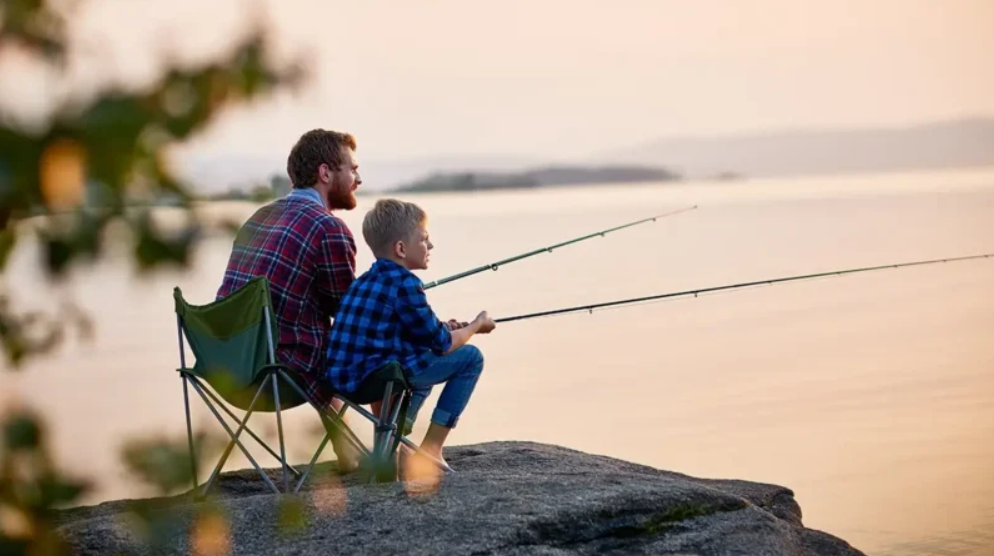
Finding the perfect Gifts for Bass Fishermen who seems to have every rod, reel, and lure can feel like casting into a weedy lake for a trophy bass—challenging but rewarding when you get it right. These passionate anglers live for the thrill of the catch, often amassing an impressive collection of gear tailored to their favorite techniques. To truly impress a bass fisherman who has everything, you need gifts that are innovative, thoughtful, or personalized, enhancing their time on the water or celebrating their love for the sport. This guide explores unique gift ideas, from cutting-edge technology to custom keepsakes, ensuring you find something that stands out. Whether it’s for a birthday, holiday, or special occasion, these gifts will make a splash for any bass angler.
You may also like to read “ Warmouth vs Rock Bass” article.
Why Unique Gifts for Bass Fishermen Matter

Bass fishing is a lifestyle, defined by early mornings on the lake, strategic lure choices, and the pursuit of that elusive lunker. For the angler who has everything, generic gifts like another tackle box or basic lures often end up unused, buried in their gear collection. Unique gifts resonate by offering something unexpected, practical, or sentimental, aligning with their passion for bass fishing. These anglers value items that improve their fishing experience, streamline their setup, or honor their achievements. For example, a personalized gift commemorating a memorable catch or a high-tech gadget they haven’t yet tried can spark genuine excitement, even for someone with a garage full of tackle.
To ensure your gift hits the mark, consider the angler’s fishing style—whether they’re a tournament pro chasing big bass or a weekend warrior enjoying local lakes. Our guide to bass fishing essentials offers insights into their world, helping you choose a gift that complements their existing gear. By focusing on originality and utility, you can find a present that stands out, no matter how well-equipped they seem.
The Challenge of Gifting the “Fully Equipped” Angler
Bass fishermen who have everything often own top-tier rods, reels, and lures from brands like Shimano, Daiwa, or Zoom, tailored to techniques like flipping, crankbaiting, or drop-shotting. Their tackle boxes are likely stocked with every color and size of soft plastics, making it tough to find something they don’t already have. The solution lies in gifts that offer novelty, enhance their fishing efficiency, or add a personal touch. A tournament angler in Florida might have every crankbait imaginable but could be thrilled by a custom rod holder engraved with their name or a tool that simplifies their boat setup.
Trends in Bass Fishing Gifts for 2025
In 2025, bass fishing gifts are trending toward technology, sustainability, and personalization. High-tech tools like advanced sonar systems and fishing-specific smartwatches are gaining traction, offering anglers an edge on the water. Eco-friendly gear, such as biodegradable lures or sustainable apparel, appeals to conservation-minded fishermen. Personalized items, like custom tackle storage or engraved keepsakes, add a sentimental touch. According to Outdoor Life, gifts like performance apparel and compact storage solutions are popular for their practicality and innovation. These trends guide our curated list, ensuring gifts that are both modern and meaningful.
Top Unique Gift Ideas for Bass Fishermen
The following gift ideas are designed to impress even the most well-equipped bass fisherman. Each is chosen for its originality, functionality, or ability to resonate with their love for the sport, ensuring your gift is a keeper, not just another item in their tackle room.
High-Tech Gadgets for the Modern Angler
Technology is revolutionizing bass fishing, offering tools that enhance precision and enjoyment. For the angler who seems to have every gadget, cutting-edge devices can still surprise. The Lowrance ActiveTarget 2 Live Sonar, available at Bass Pro Shops, provides real-time underwater imaging, allowing anglers to see bass movements with unmatched clarity. Unlike traditional fish finders, this system shows fish reacting to lures, perfect for targeting suspended bass. An angler fishing Lake Guntersville might use ActiveTarget to locate a school hiding near a submerged hump, gaining a competitive edge in a tournament.
Another innovative option is the Garmin Fish Hunter Smartwatch, which combines GPS, weather tracking, and fishing forecasts based on moon phases and barometric pressure. Waterproof and durable, it’s ideal for planning fishing trips. A weekend angler in Michigan could use it to time their casts during peak feeding periods on Lake St. Clair, boosting their catch rate. These high-tech gifts, while premium, offer functionality that even seasoned anglers will appreciate, making them standout presents.
Personalized Fishing Gear and Keepsakes
Personalized gifts add a heartfelt touch, perfect for anglers who cherish their fishing memories. A custom-engraved tackle box from Etsy can feature the angler’s name, a favorite lake, or a memorable date, transforming a practical item into a treasured keepsake. Picture an angler in Minnesota opening a tackle box engraved with “Lake Mille Lacs Master” before a weekend trip—it’s both useful and deeply personal.
Another sentimental option is a custom fish replica or photo book that captures their biggest bass. Companies like Printed Memories offer photo books where you can compile images of their catches, tournaments, or fishing trips with family. A father in Georgia might treasure a book documenting his fishing adventures with his kids, preserving those moments for years. These personalized gifts celebrate the angler’s passion, making them ideal for those who seem to have it all.
Performance Apparel and Accessories
High-quality apparel designed for bass fishing combines style, comfort, and functionality, making it a thoughtful gift for anglers who spend long hours on the water. The Huk Icon X Hoodie, highlighted by Bassmaster, offers UPF 50+ sun protection, moisture-wicking fabric, and a lightweight design, perfect for hot summer days. Its built-in face gaiter provides extra sun coverage, ideal for an angler fishing Florida’s Lake Okeechobee under intense sunlight.
For enhanced visibility, Costa’s Fantail PRO Polarized Sunglasses, available at Costa Del Mar, feature 580 lens technology to cut glare and improve clarity. These shades help anglers spot bass in shallow waters or structure in bright conditions. An angler in Tennessee might use them to see through the glare on a sunny day, improving their casting accuracy. Pair the sunglasses with a waterproof hat from Simms for a complete outfit that’s both stylish and practical.
Organization and Storage Solutions
Even the most equipped bass fisherman can benefit from better organization. The Plano Edge Master Tackle Box, praised by Discover Boating, features customizable compartments and rust-resistant technology, perfect for organizing lures and terminal tackle. Its waterproof seal protects gear in wet conditions, making it ideal for boat or shore anglers. An angler in Ohio might use this box to keep their soft plastics sorted for a day on Lake Erie, appreciating its durability and compact design.
Experiential and Subscription Gifts
For anglers who have all the gear, experiential gifts offer unforgettable memories. A guided bass fishing trip with a local expert provides new techniques and access to prime waters. Resources like TakeMeFishing.org list local guides for top bass lakes. An angler in South Carolina might join a guide on Lake Murray, learning advanced finesse techniques while targeting trophy bass, creating a day they’ll never forget.
Alternatively, a Mystery Tackle Box Elite subscription, available at Shop Karls, delivers curated bass lures and tackle monthly. This gift introduces new baits from top brands, keeping even seasoned anglers excited. A young angler in Illinois might discover a unique soft plastic in their box, landing their personal-best bass on Lake Shelbyville. Subscriptions offer ongoing surprises, making them a gift that keeps giving throughout the year.
Comparison Table: Unique Gifts for Bass Fishermen
The table below summarizes our top gift ideas, helping you choose the perfect present based on type, price range, and appeal.
| Gift Item | Type | Price Range | Best For |
|---|---|---|---|
| Lowrance ActiveTarget 2 Sonar | Technology | $1500–$2000 | Tech-savvy tournament anglers |
| Custom-Engraved Tackle Box | Personalized | $50–$150 | Sentimental anglers |
| Huk Icon X Hoodie | Apparel | $50–$100 | Sun-conscious fishermen |
| Plano Edge Master Tackle Box | Storage | $40–$80 | Organized shore anglers |
| Guided Fishing Trip | Experiential | $200–$500 | Anglers seeking new skills |
Real-World Gift Scenarios
Real-world examples show the impact of these unique gifts. Imagine gifting a Lowrance ActiveTarget 2 Sonar to a tournament angler in Alabama for their birthday. During their next event on Lake Eufaula, they use the sonar to locate a hidden bass school near a submerged ledge, securing a top finish and raving about the gift’s game-changing clarity. In another scenario, a retiree in Wisconsin receives a custom-engraved tackle box for Father’s Day, inscribed with “Grandpa’s Fishing Legacy.” Each time they open it on a trip to Lake Winnebago, they’re reminded of family and their love for bass fishing.
Consider a young angler in Florida receiving a Mystery Tackle Box subscription for their graduation. Each month, they eagerly await new lures, testing a unique crankbait on Lake Istokpoga that lands their personal-best 8-pound bass. These stories highlight how thoughtful gifts can enhance an angler’s experience, creating lasting memories on and off the water.
Tips for Choosing the Perfect Gift
Selecting a gift for a bass fisherman who has everything requires a bit of strategy. Start by observing their fishing habits—do they fish from a boat or shore? Are they tech-focused or traditional? If possible, ask subtle questions about their gear preferences or check with fishing buddies for insights. Consider their personality: a sentimental angler might love a personalized keepsake, while a competitive one might prefer a high-tech tool. Budget is also key—high-end gifts like sonar systems are ideal for special occasions, while apparel or subscriptions suit smaller budgets.
Tailor your choice to their fishing environment. An angler in cold northern lakes might appreciate insulated apparel, while one in sunny southern waters might value polarized sunglasses. Shopping at reputable retailers like Cabela’s ensures quality and a wide selection of fishing gear. By aligning your gift with their needs and passions, you’ll deliver a present that’s both practical and memorable, earning you a spot as their favorite gift-giver.
Conclusion
Finding unique gifts for a bass fisherman who has everything is a rewarding challenge when you focus on innovation, personalization, and practicality. From high-tech tools like the Lowrance ActiveTarget 2 Sonar to sentimental keepsakes like custom-engraved tackle boxes, these gifts elevate the angling experience while celebrating their passion for bass fishing. Performance apparel, smart storage solutions, and experiential gifts like guided trips offer something for every angler, regardless of their gear collection. Whether they’re casting on a legendary lake or organizing their tackle at home, your thoughtful gift will make their next fishing adventure unforgettable. Dive into our curated ideas, consider their fishing style, and reel in a present that lands a smile as big as their biggest bass.
Fishing Guides
Warmouth vs Rock Bass – Which Species Reigns Supreme?
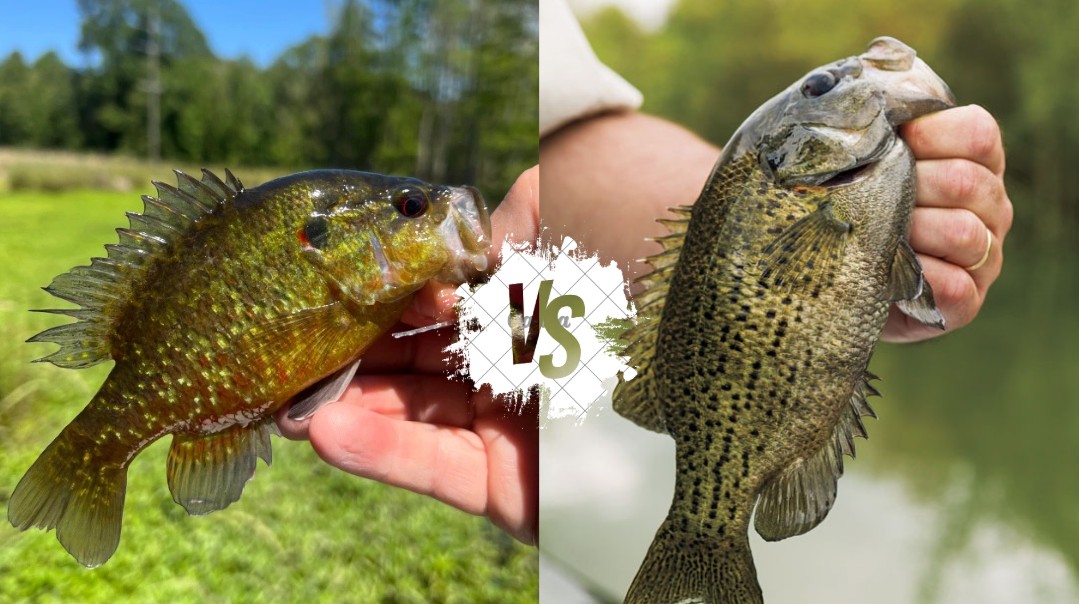
The warmouth and rock bass are two feisty panfish that ignite passion among anglers, sparking debates over which species offers the better fishing experience. Both belong to the sunfish family, sharing traits like spiny fins and a love for cover, but their unique characteristics—appearance, behavior, habitat, and angling appeal—set them apart. Whether you’re casting in a murky southern pond or a clear northern stream, deciding whether warmouth or rock bass reigns supreme depends on your fishing goals. This comprehensive guide compares these species across multiple dimensions, providing practical insights and real-world examples to help anglers choose their champion.
You may also like to read “ Lifespan of a largemouth bass” article.
Introducing Warmouth and Rock Bass
Warmouth (Lepomis gulosus) and rock bass (Ambloplites rupestris) are beloved for their accessibility, aggressive bites, and spirited fights, making them ideal targets for beginners and seasoned anglers alike. The warmouth, often nicknamed “goggle-eye” for its large eyes, thrives in warm, sluggish waters and is known for its voracious appetite. The rock bass, or “redeye” due to its striking red eyes, prefers cooler, clearer streams and lakes, delivering a scrappy battle on light tackle. Each species brings something unique to the table, from habitat preferences to angling challenges.
Choosing between them hinges on factors like ease of catching, fight quality, or culinary value. For anglers looking to hone their panfish skills, our guide to panfish fishing techniques offers strategies tailored to species like warmouth and rock bass. By exploring their differences and similarities, we’ll determine which fish deserves the crown in the eyes of anglers.
Warmouth: The Bold Predator
Native to the southeastern United States but widely introduced, warmouth flourish in warm, slow-moving waters such as ponds, swamps, and bayous. They typically grow to 6–10 inches, with some reaching 12 inches and weighing up to a pound. Their olive-to-brown bodies, adorned with mottled, chain-like patterns, blend seamlessly into weedy or muddy environments. Warmouth are aggressive feeders, devouring insects, small fish, and crustaceans, which makes them a reliable target year-round. An angler fishing a Louisiana marsh might hook a warmouth ambushing a minnow in shallow grass, its bold strike showcasing its predatory instincts.
Rock Bass: The Stream Warrior
Rock bass, native to the eastern United States and parts of Canada, favor cooler, clearer waters like rocky streams, rivers, and lakes. They also grow to 6–10 inches, with larger specimens hitting 12 inches and a pound. Their olive-green bodies, marked by dark horizontal stripes and vivid red eyes, make them unmistakable. Feeding on insects, crayfish, and small fish, rock bass often lurk near rocks or logs, darting out to strike. An angler casting in Michigan’s Au Sable River might catch a rock bass hiding near a sunken log, its quick, energetic fight a testament to its stream-bred tenacity.
Appearance and Identification
Accurate identification is essential, as warmouth and rock bass can inhabit overlapping waters, leading to occasional confusion. While both share a sunfish-like shape, their coloration, markings, and physical features provide clear distinctions for observant anglers.
Identifying Warmouth
Warmouth have a stout, slightly elongated body with a large mouth, reflecting their scientific name “gulosus” (gluttonous). Their coloration varies from olive to dark brown, with mottled patterns and faint vertical bars. Key identifiers include their large, red or orange eyes—especially vivid in juveniles—and a unique patch of teeth on their tongue. They have 10–11 dorsal fin spines and often display a reddish gill flap edge. An angler fishing a murky Alabama pond might spot a warmouth’s glowing eyes in the shallows, a telltale sign of its presence.
Identifying Rock Bass
Rock bass sport a more streamlined body, with olive-green to bronze coloration and dark, horizontal stripes that fragment into spots toward the belly. Their hallmark is their bright red eyes, earning the “redeye” nickname. They have 5–7 anal fin spines and a slightly forked tail, setting them apart from warmouth. In the clear waters of Ontario’s St. Lawrence River, an angler might notice a rock bass’s red eyes shining against a gravel bottom, making identification straightforward. The U.S. Fish and Wildlife Service provides detailed fish identification resources for anglers seeking clarity.
Habitat and Distribution
Habitat preferences heavily influence where and how anglers pursue warmouth and rock bass. While both species gravitate toward cover-rich environments, their tolerances for water conditions shape their geographic ranges and fishing strategies.
Warmouth Habitat
Warmouth excel in warm, sluggish, or still waters with dense vegetation, such as ponds, lakes, swamps, and slow rivers. They tolerate low oxygen and turbid conditions, thriving from Florida to Texas and as far north as Missouri. They hide near weeds, stumps, or submerged logs, ambushing prey with precision. An angler fishing Georgia’s Okefenokee Swamp might find warmouth lurking in lily pads, striking a small jig cast near cover. Their adaptability to murky, vegetated waters makes them a staple in southern fisheries.
Rock Bass Habitat
Rock bass prefer cooler, clearer waters, including rocky streams, rivers, and lakes with gravel or boulder-strewn bottoms. They’re common from Quebec to the Mississippi River basin, flourishing in places like the Great Lakes and Appalachian waterways. They seek cover near rocks, logs, or undercut banks, using these as ambush points. An angler casting in Virginia’s Shenandoah River might hook a rock bass near a rocky ledge, where it waits for passing crayfish. Their affinity for clear, rocky waters makes them a northern favorite.
Fishing Techniques for Warmouth and Rock Bass
Catching warmouth and rock bass demands tailored approaches, as their habitats and feeding habits require different tactics. Both species are aggressive, making them accessible with simple gear, but specific techniques can elevate your success.
Catching Warmouth
Warmouth respond well to light tackle, such as ultralight spinning rods with 4–6-pound test line. Small jigs, inline spinners, or live baits like worms, crickets, or minnows are effective, especially when fished near cover. A 1/32-ounce jig tipped with a soft plastic grub, worked slowly through weeds, can trigger a strike. Float fishing with a worm under a bobber shines in shallow waters. An angler fishing a Mississippi oxbow lake might use a cricket under a float, landing an 8-inch warmouth hiding in cattails.
Catching Rock Bass
Rock bass are best targeted with light spinning or fly-fishing gear, using 4–8-pound test line and small lures like spinners, crankbaits, or soft plastics. Live baits, such as minnows or crayfish tails, work wonders near rocky structure. Fly anglers can use small streamers or nymphs to mimic insects or baitfish. An angler fishing Wisconsin’s Wolf River might cast a Rooster Tail spinner near a boulder, hooking a 9-inch rock bass. Fishing at dawn or dusk, when rock bass are most active, increases bites. Retailers like Cabela’s stock lures perfect for rock bass angling.
Fight Quality and Angling Experience
The fight delivered by warmouth and rock bass is a major factor in their appeal, as both offer exciting battles on light tackle. Their distinct fighting styles influence which species anglers might prefer.
Warmouth’s Tenacious Fight
Warmouth are relentless fighters, using their broad bodies to pull hard and dive for cover. They shake their heads or roll, creating a challenge on ultralight gear. A 10-inch warmouth can feel like a larger fish, especially in thick vegetation where it tries to wrap the line. An angler fishing a Florida canal might battle a warmouth that burrows into hydrilla, requiring careful rod work to land. Their bulldog-like aggression makes them a thrilling catch, earning high praise for fight quality.
Rock Bass’s Energetic Battle
Rock bass are known for quick, darting runs and relentless energy, often leaping or spinning during the fight. Their streamlined shape enables rapid bursts, making them a joy on light tackle or fly rods. In fast-moving streams, they leverage currents, adding to the challenge. An angler fishing New York’s Catskill streams might hook a rock bass that zips toward a rock pile, testing their finesse. The rock bass’s acrobatic, lively fight captivates anglers seeking action-packed encounters.
Culinary Value and Table Fare
For anglers who enjoy eating their catch, the culinary qualities of warmouth and rock bass are worth comparing. Both are edible, but differences in flavor and preparation affect their appeal as table fare.
Warmouth on the Plate
Warmouth have firm, white flesh with a mild, slightly sweet flavor, making them a solid choice for panfish meals. Their larger size yields more fillets than smaller sunfish, though bones require careful removal. Pan-frying or baking with simple seasonings brings out their best. An angler in Arkansas might keep a few 9-inch warmouth for a fish fry, enjoying their crispy texture after coating in cornmeal. Proper filleting, as advised by Bassmaster, ensures a bone-free dining experience.
Rock Bass on the Plate
Rock bass offer flaky, white flesh with a mild, slightly earthier taste than warmouth. Their smaller size means less meat, and bones can be tedious to remove. Grilling or pan-frying with herbs enhances their flavor. An angler in Ohio might cook a 10-inch rock bass for a lakeside lunch, savoring its delicate taste after a morning of fishing. While tasty, their limited fillet size makes them less ideal for large meals compared to warmouth.
Warmouth vs. Rock Bass Comparison Table
The table below highlights key differences between warmouth and rock bass, aiding anglers in choosing their preferred target.
| Feature | Warmouth | Rock Bass |
|---|---|---|
| Appearance | Mottled olive-brown, large red/orange eyes | Olive-green, red eyes, dark stripes |
| Habitat | Warm, murky ponds, swamps, slow rivers | Cool, clear streams, rocky lakes |
| Size | 6–10 inches, up to 1 pound | 6–10 inches, up to 1 pound |
| Fight | Aggressive, dives for cover | Quick, darting, acrobatic |
| Best Baits | Worms, jigs, small plastics | Spinners, minnows, streamers |
| Table Fare | Mild, sweet, firm flesh | Mild, earthy, flaky flesh |
Real-World Angling Scenarios
Real-world examples illustrate the strengths of both species. Picture an angler fishing a weedy South Carolina pond, casting a small jig near submerged timber. They hook a 10-inch warmouth that dives into the grass, its stubborn fight requiring finesse to land. The warmouth’s aggression shines in such murky, cover-rich waters. Meanwhile, an angler fly-fishing in a clear West Virginia stream targets a rock bass near a gravel bar. The fish strikes a nymph, darting and leaping in a spirited battle that highlights its stream-bred energy.
Another scenario unfolds during a family fishing trip in Indiana’s White River. The kids use worms under bobbers, catching rock bass that thrill them with their red eyes and quick runs. Nearby, their parent hooks a warmouth in a muddy backwater, impressed by its bulldog-like pull on a spinner. These experiences show that both fish offer excitement, with the “supreme” species tied to the angler’s environment and preferences.
Deciding the Champion
Choosing between warmouth and rock bass depends on what an angler values most. Warmouth shine in warm, murky waters, offering aggressive fights and decent table fare, making them a top pick for southern anglers fishing vegetated ponds or swamps. Their adaptability and bold feeding give them an edge in accessibility. Rock bass, thriving in clear, rocky streams, deliver acrobatic battles and striking red eyes, appealing to northern anglers and fly-fishers. Their lively fight and aesthetic charm make them a streamside favorite.
For versatility and ease of catching, warmouth may claim the title, especially in diverse, murky habitats where their tolerance shines. For fight quality and visual appeal, rock bass could take the crown, particularly in clear waters where their energy stands out. Ultimately, both species are exceptional, offering unique angling experiences. An angler fishing a Tennessee pond one day and a Kentucky stream the next might cherish warmouth and rock bass equally, finding no definitive winner but plenty of joy.
Conclusion
The warmouth vs. rock bass rivalry highlights the diversity and thrill of panfish angling. Warmouth, with their aggressive strikes and murky-water prowess, are a reliable target for southern anglers, delivering tenacious fights and tasty fillets. Rock bass, excelling in clear, rocky waters, offer acrobatic battles and striking red eyes, captivating northern anglers and fly-fishers. Their differences in habitat, behavior, and angling experience make them equally compelling, with the “supreme” species depending on your fishing style and setting. Whether casting in a weedy bayou or a rocky river, warmouth and rock bass promise excitement and memories, proving that both reign supreme in their respective domains.
Fishing Guides
What is the lifespan of a largemouth bass

The largemouth bass, a prized gamefish known for its aggressive strikes and acrobatic fights, is a cornerstone of freshwater angling across North America and beyond. Anglers and conservationists alike often wonder about the lifespan of this iconic species, as it impacts fishery management, catch-and-release practices, and the pursuit of trophy fish. The lifespan of a largemouth bass varies based on environmental factors, predation, fishing pressure, and genetics, but understanding these dynamics offers valuable insights for sustaining healthy populations. In this comprehensive guide, we explore the lifespan of largemouth bass, the factors influencing it, and practical implications for anglers.
You may also like to read “ The Fisherman’s Guide to Lucky Sayings” article.
Understanding the Lifespan of Largemouth Bass
Largemouth bass (Micropterus salmoides) typically live between 10 and 16 years in the wild, though exceptional individuals have been recorded reaching up to 20 years or more under ideal conditions. Their lifespan is influenced by a complex interplay of biological and environmental factors, with older fish often growing to impressive sizes, making them coveted trophies. Knowing how long largemouth bass live helps anglers appreciate the value of catch-and-release and informs fishery management strategies to ensure sustainable populations.
The longevity of largemouth bass is remarkable for a freshwater fish, as they face numerous challenges, including predation, habitat changes, and fishing pressure. For anglers aiming to target these fish responsibly, our guide to ethical fishing practices provides tips on handling bass to maximize their post-release survival, preserving older, breeding-age fish. By delving into the science of their lifespan, we can better understand how to support thriving bass populations for future generations.
The Biology of Largemouth Bass Longevity
Largemouth bass grow rapidly in their first few years, reaching sexual maturity around 2–3 years of age. As they age, growth slows, but older fish can attain weights of 10–20 pounds or more in nutrient-rich waters. Their lifespan is tied to their ability to survive environmental stressors, avoid predation, and access food. Unlike some fish species with shorter lifespans, largemouth bass benefit from a robust physiology, including a strong immune system and adaptability to varied habitats. For example, a bass in a fertile Florida lake might live 15 years, growing to 12 pounds, while one in a harsher northern lake may reach only 10 years and 5 pounds.
Why Lifespan Matters to Anglers
The lifespan of largemouth bass directly affects angling opportunities. Older bass are typically larger, making them prime targets for trophy hunters. However, these fish are also key breeders, producing thousands of eggs each spawning season, which sustains populations. Releasing older bass ensures they continue to contribute to the fishery. An angler fishing Lake Fork in Texas, known for its trophy bass, might release a 10-pound largemouth, knowing it could live another 5–10 years and spawn multiple times, bolstering the lake’s reputation for big fish.
Factors Influencing Largemouth Bass Lifespan
Several factors determine how long a largemouth bass can live, ranging from environmental conditions to human activities. Understanding these variables helps anglers and fishery managers promote longer, healthier lives for bass.
Environmental Conditions
Water quality, temperature, and food availability are critical to largemouth bass longevity. Clean, oxygen-rich waters with stable temperatures support healthy growth and immune function. Lakes and rivers with abundant prey, such as bluegill, shad, or crawfish, allow bass to thrive. In contrast, polluted or low-oxygen waters can stunt growth and shorten lifespans. For instance, a largemouth bass in Minnesota’s Lake Minnetonka, with clear water and plentiful forage, might live 14 years, while one in a polluted urban pond may survive only 8 years. Resources like the U.S. Fish and Wildlife Service provide data on water quality and its impact on fish populations.
Predation and Competition
Young largemouth bass face heavy predation from birds, larger fish, and even other bass, with only a small percentage surviving to adulthood. As they grow, their size reduces predation risk, but competition for food and territory can limit lifespan. In crowded lakes, bass may struggle to secure enough resources, slowing growth and weakening their resilience. An angler fishing a small, overpopulated pond in Georgia might catch many small bass, indicating high competition that could cap lifespans at 6–8 years.
Fishing Pressure and Harvest
Fishing pressure significantly affects largemouth bass lifespan, especially in heavily fished waters. Harvesting large, older bass removes key breeders from the population, while catch-and-release, when done poorly, can cause stress or injury, reducing survival. Regulations, such as slot limits or catch-and-release mandates, help protect older fish. For example, a bass in Florida’s Lake Okeechobee, protected by strict size limits, might reach 18 years, while one in an unregulated fishery faces a higher risk of harvest at a younger age.
Growth Stages and Lifespan Milestones
Largemouth bass go through distinct growth stages, each with implications for their lifespan and role in the ecosystem. These stages influence how anglers interact with bass and inform conservation strategies.
Juvenile Stage (0–3 Years)
In their first three years, largemouth bass grow rapidly, reaching 10–14 inches and sexual maturity. This stage is the most vulnerable, with high mortality from predation and environmental stress. Juvenile bass rely on cover, like weeds or fallen logs, to avoid predators. An angler fishing a weedy bay in Wisconsin might catch a 12-inch bass, a 2-year-old survivor of this risky stage, highlighting the importance of preserving habitat for young fish.
Adult Stage (4–10 Years)
Adult bass, typically 14–20 inches, are strong competitors and prolific breeders. They can live 10–12 years in this stage, depending on conditions, and are prime targets for anglers. These fish play a critical role in maintaining population stability through spawning. A tournament angler on Alabama’s Lake Guntersville might catch a 5-pound, 6-year-old bass, releasing it to ensure it continues producing offspring for the fishery.
Trophy Stage (11+ Years)
Bass over 11 years old, often exceeding 20 inches and 8 pounds, are considered trophies. These fish are rare, as they’ve survived years of challenges, and their longevity makes them valuable for spawning. In ideal conditions, some reach 15–20 years. An angler fishing California’s Lake Casitas might hook a 15-pound, 16-year-old bass, a living testament to the lake’s healthy ecosystem and conservation efforts.
Regional Variations in Lifespan
Largemouth bass lifespans vary by region due to differences in climate, water quality, and management practices. These variations offer insights into how geography shapes bass populations.
Southern United States
In southern states like Florida, Texas, and Louisiana, warm climates and long growing seasons allow largemouth bass to grow quickly and live longer, often 12–18 years. Nutrient-rich waters support large sizes, with some bass exceeding 20 pounds. An angler fishing Florida’s Rodman Reservoir might catch a 10-pound bass estimated at 14 years old, reflecting the region’s favorable conditions. Organizations like Florida Fish and Wildlife Conservation Commission (FWC) monitor these populations to ensure sustainability.
Northern United States
In northern states like Michigan, Wisconsin, and New York, colder climates and shorter growing seasons slow bass growth, with lifespans typically ranging from 8–12 years. Bass in these regions rarely exceed 10 pounds but are still prized for their fight. An angler on Minnesota’s Mille Lacs Lake might catch a 4-pound, 10-year-old bass, a respectable fish for the region’s cooler waters.
Managed Fisheries vs. Wild Waters
Managed fisheries, such as private lakes or reservoirs with stocking programs, often produce longer-lived bass due to controlled conditions and limited harvest. Wild rivers or public lakes with heavy fishing pressure may see shorter lifespans. A bass in a private Texas lake with supplemental feeding might live 20 years, while one in a public Ohio river faces higher risks, capping its lifespan at 10 years.
Lifespan Factors Table
The table below summarizes key factors affecting largemouth bass lifespan, providing a quick reference for anglers and conservationists.
| Factor | Impact on Lifespan | Best Practice |
|---|---|---|
| Water Quality | Clean, oxygen-rich water extends life to 12–18 years | Support habitat restoration efforts |
| Predation | High predation reduces juvenile survival | Preserve cover like weeds and logs |
| Fishing Pressure | Heavy harvest shortens lifespan to 6–10 years | Practice catch-and-release, follow regulations |
| Food Availability | Abundant prey supports longer life and growth | Protect forage species like bluegill |
| Climate | Warm climates extend life; cold climates shorten it | Tailor fishing practices to regional conditions |
Real-World Examples of Largemouth Bass Longevity
Largemouth bass longevity is evident in real-world fishing scenarios. Consider a tournament angler on Lake Fork, Texas, catching a 13-pound bass estimated at 15 years old based on scale analysis. The fish, released after a quick weigh-in, likely continues to spawn, supporting the lake’s trophy fishery. In another case, a recreational angler on Florida’s St. Johns River catches a 9-pound bass, aged at 12 years by a local biologist, showcasing the benefits of catch-and-release in a managed fishery.
A contrasting example highlights the impact of poor management. In an overfished public lake in Ohio, most bass are harvested before reaching 8 years, limiting the population to smaller, younger fish. An angler there might catch a 3-pound, 5-year-old bass, unaware that unchecked harvest prevents older, larger fish from thriving. These examples, supported by insights from Bassmaster, underscore the importance of conservation for maximizing bass lifespan.
Implications for Anglers and Conservation
The lifespan of largemouth bass has significant implications for angling and fishery management. Older bass are not only trophy targets but also critical for population stability, as they produce more eggs than younger fish. Anglers can support longevity by practicing catch-and-release, using barbless hooks, and handling fish gently to minimize stress. For instance, an angler on South Carolina’s Lake Marion might use a knotless net and keep a 7-pound bass in the water while unhooking it, ensuring its survival for another spawning season.
Conservation efforts, such as those by the B.A.S.S. Conservation Program, promote habitat restoration, stocking programs, and regulations like slot limits to protect older bass. Supporting these initiatives ensures bass live longer and grow larger, benefiting anglers and ecosystems. An angler volunteering for a lake cleanup in Tennessee might help improve water quality, indirectly extending the lifespan of local bass populations.
Tips for Promoting Bass Longevity
To help largemouth bass reach their full lifespan potential, adopt these practices. Fish during cooler times of day to reduce stress, especially in warm climates. Use fish-friendly gear, like rubber nets and weigh bags, to minimize injury. Advocate for regulations that protect spawning bass, such as seasonal closures or size limits. Educate fellow anglers about the importance of releasing trophy fish. An angler on Arkansas’s Lake Ouachita might release a 10-pound bass after a quick photo, knowing it could live another decade and produce thousands of offspring.
Participating in citizen science, such as reporting tagged fish to agencies like the FWC, helps track bass longevity and population health. By combining responsible angling with conservation advocacy, you contribute to a future where largemouth bass thrive for generations.
Conclusion
The lifespan of a largemouth bass—typically 10–16 years, with some reaching 20 years—reflects the interplay of biology, environment, and human impact. Factors like water quality, predation, fishing pressure, and climate shape how long these fish live, with southern bass often outliving their northern counterparts. Older bass are vital for trophy angling and population sustainability, making catch-and-release and conservation critical. Real-world examples, from Texas trophy lakes to overfished Ohio waters, highlight the importance of responsible practices. Armed with insights from this guide and resources like Bassmaster and the FWC, anglers can ensure largemouth bass reach their full potential, preserving the thrill of the catch for years to come. Next time you hook a bass, handle it with care—its longevity depends on it.
-
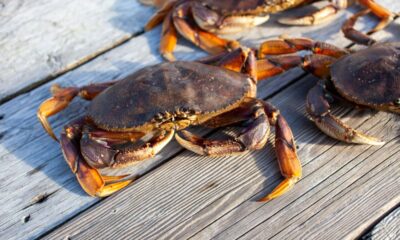
 Fishing Guides5 months ago
Fishing Guides5 months agoWhy Is Dungeness Crab Season So Popular?
-
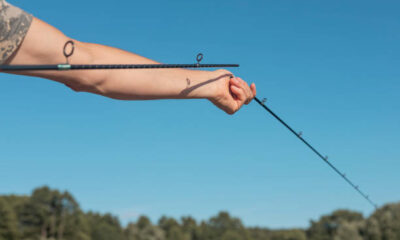
 Equipment11 months ago
Equipment11 months agoHow to Repair a Broken Fishing Rod Tip Like a Pro
-

 Fishing Guides1 year ago
Fishing Guides1 year agoThe Secret to Catching More Catfish: Chicken Gizzards as Bait
-

 Fishing Guides1 year ago
Fishing Guides1 year agoA Beginner’s Guide to Smallmouth Bass Fishing
-

 Equipment11 months ago
Equipment11 months ago10 Reasons to Choose the Ozark Trail Kayak Angler 10
-

 Fishing Guides1 year ago
Fishing Guides1 year agoThe Truth About Mullet Fish: Is It a Delicious and Nutritious Fish?
-
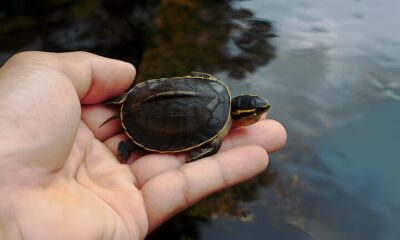
 Fishing Guides1 year ago
Fishing Guides1 year agoHow to Trap Snapping Turtles Safely: Every tip you need to know
-

 Fishing Guides11 months ago
Fishing Guides11 months agoDungeness Crab vs Snow Crab: Which is the Winner?
